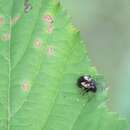en
names in breadcrumbs


The Eumolpinae are a subfamily of the leaf beetles, or Chrysomelidae. It is one of the largest subfamilies of leaf beetles,[1] including more than 500 genera and 7000 species.[2] They are oval, and convex in form, and measure up to 10 mm in size. Typical coloration for this subfamily of beetles ranges from bright yellow to dark red. Many species are iridescent or brilliantly metallic blue or green in appearance.
Eumolpinae can be recognized at first sight by their rounded thoraces, more or less spherical or bell-shaped, but always significantly narrower than the mesothorax as covered by the elytra. Additional features include a small head set deeply into the thorax, and usually well-developed legs.
They generally resemble other Chrysomelidae, but differ in having front coxae rounded and third tarsal segment bilobed beneath. Many are metallic, or yellow and spotted. The dogbane beetle (Chrysochus auratus), for instance, is very attractive—iridescent blue-green with a coppery tinge, it measures 8–10 mm, and is found on dogbane and milkweed. Some, such as members of the genus Macrocoma, are unusually setaceous and with unusually prominent mandibles for members of the family Chrysomelidae.
The Eumolpinae are distributed worldwide. They are numerous in the tropics and subtropics, particularly in South America, tropical Africa, Australia, New Guinea, Fiji and New Caledonia, but are progressively less common towards the north.[2] They have a high species richness in New Caledonia.[3]
Brachypnoea sp.
Dogbane Beetle - Chrysochus auratus
The number of tribes in the subfamily varies depending on the author. According to a classification from 2011, for instance, there are 12 tribes:[4]
The tribe Eupalini was proposed in 2005 for the genus Eupales (also known as Floricola).[5] However, the name "Eupalini" was not explicitly indicated as new, so it is currently considered an unavailable name according to the ICZN.
The subfamily Spilopyrinae was formerly considered a tribe of Eumolpinae, while recently the subfamily Synetinae has sometimes been grouped within Eumolpinae.
The Eumolpinae are a subfamily of the leaf beetles, or Chrysomelidae. It is one of the largest subfamilies of leaf beetles, including more than 500 genera and 7000 species. They are oval, and convex in form, and measure up to 10 mm in size. Typical coloration for this subfamily of beetles ranges from bright yellow to dark red. Many species are iridescent or brilliantly metallic blue or green in appearance.